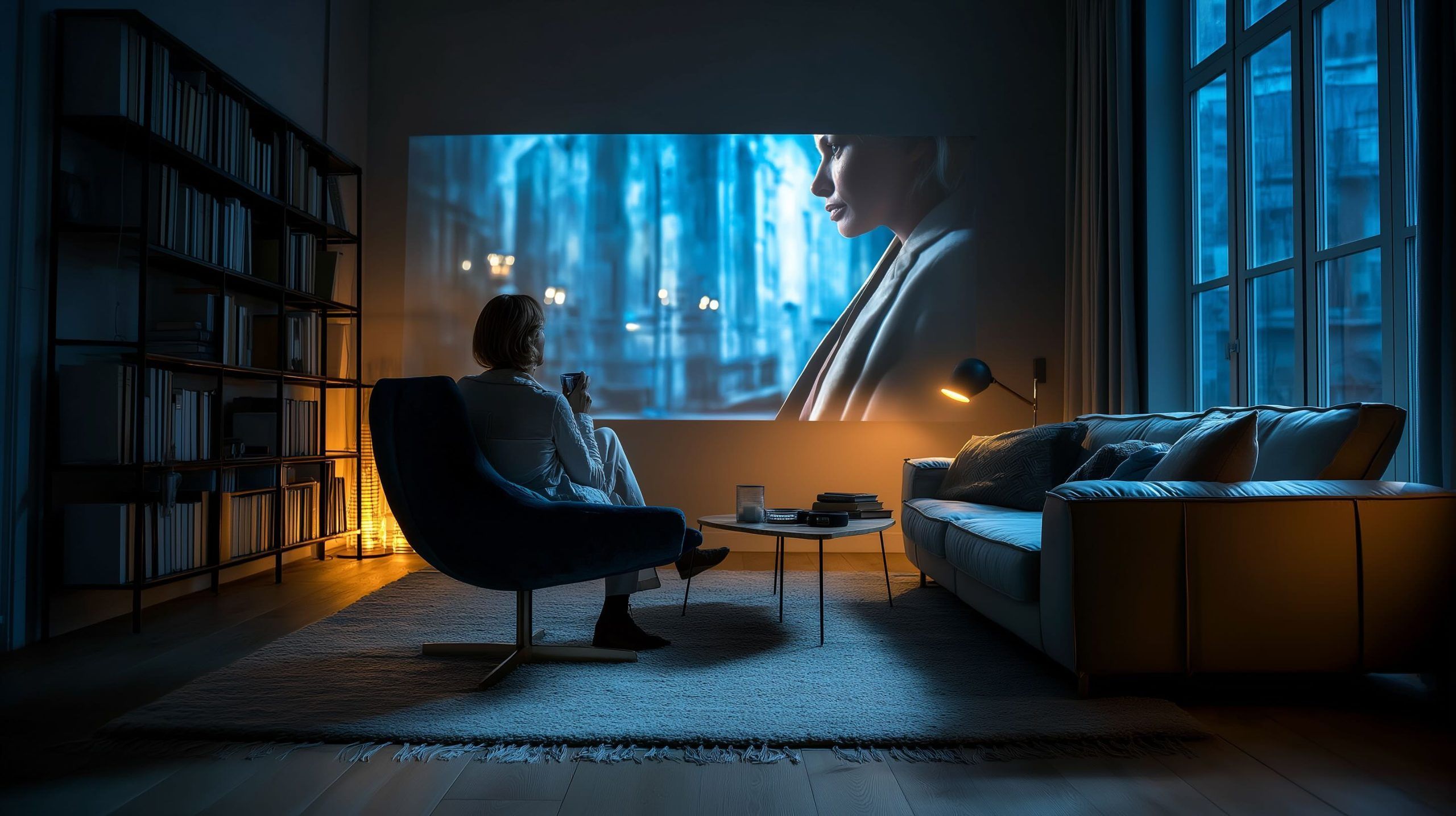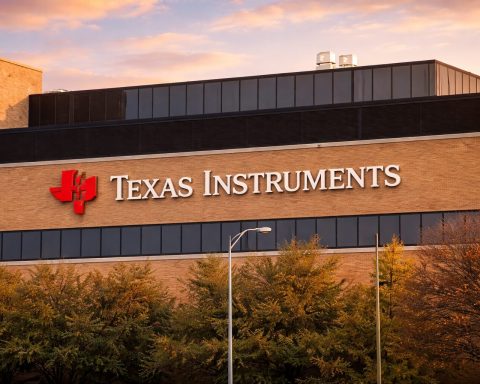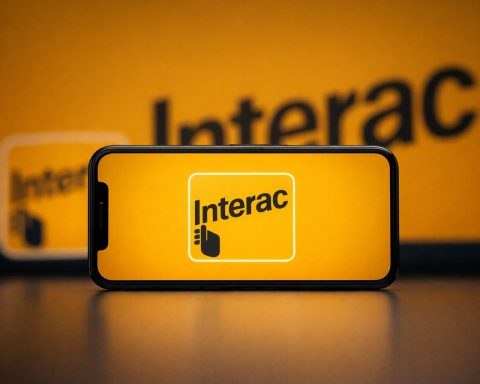- In 2025, a midrange projector plus a screen can deliver a 120-inch image for about $2,000, cheaper than most 98-inch LED TVs.
- The Epson LS12000 uses a laser light engine with 3LCD imaging to produce a native 4K (3840×2160) picture with deep blacks and 1,500–3,000 lumens brightness.
- JVC’s DLA-NZ8 and NZ9 are native 4K (D-ILA) projectors famed for deep blacks, with some models offering 8K e-shift upscaling.
- No consumer projector has a native 8K chip in 2025; 8K is achieved via techniques like e-shift on high-end models, often costing around $25,000.
- The BenQ X3100i is a 4LED DLP projector that delivers 4K HDR via XPR pixel shifting and sits around $2,000.
- Dolby Vision HDR first appeared in XGIMI’s Horizon Ultra (2023) and is increasingly supported on newer projectors like Aura 2 UST, signaling broader HDR processing.
- Hisense’s L9Q TriChroma Laser TV can reach up to 5,000 lumens peak brightness and about 1,500 nits on screen with an ALR screen.
- Samsung’s The Premiere 8K UST prototype shown at CES can throw a 150-inch image from about 12 inches away, with 4,000 lumens and wireless HDMI.
- Laser/LED light sources now dominate, offering 20,000+ hour lifespans and instant on/off with lower maintenance than lamp-based projectors.
- Smart features abound: many 2025 projectors run Android TV/Google TV with Netflix certification, such as Hisense L9Q and DBPOWER E2, reducing need for external streaming boxes.
Introduction: The appeal of home projectors is surging in the streaming era. With limitless movies and shows at our fingertips, many viewers want a true cinematic experience at home – something even a big TV can’t fully deliver. This has led to a renaissance in consumer projectors. Modern projectors offer gigantic screen sizes (100″ and beyond) for a fraction of what an equivalently massive TV would cost, and new technologies have narrowed the quality gap between projected images and flat-panel TVs. In an age of binge-watching, the idea of turning your living room wall into a movie theater is more attractive than ever. Instead of gathering around a 75-inch TV, families can now gather for a 120-inch movie night – all thanks to brighter, smarter, and more user-friendly projectors designed for today’s streaming needs. Industry forecasts reflect this trend: the global home theater market is on track for robust growth through the 2020s. In short, projectors have evolved from niche gadgets for dark basement theaters into versatile, living-room-ready displays that may replace your next TV.
Projectors vs. TVs in the Streaming Age
Why consider a projector over a traditional television? For starters, projectors excel at screen size for the price. Even midrange projectors can cast 100–150″ images, far larger than all but the most expensive TVs. This means a more immersive view – your own private cinema for streaming the latest Netflix blockbuster or live sports game. As one AV expert put it, “projectors…remain the most viable technologies for making impressively large images at consumer-friendly prices”. In practical terms, a $2,000 projector paired with a screen can yield a 120″ picture, whereas an 98″ LED TV often costs well above that and still offers a smaller image (and can dominate a room even when off). The value proposition tilts in favor of projectors once you crave truly big-screen entertainment.
Moreover, the streaming revolution makes projectors more convenient than ever. With so much content on demand, you’re no longer tied to living room cable hookups – you can set up a projector anywhere there’s Wi-Fi and a blank wall. Modern smart projectors come loaded with Netflix, YouTube, Disney+ and other apps built-in, essentially functioning as all-in-one smart TVs that happen to use a projection engine instead of an LCD/OLED panel. This convergence means less fuss with external boxes or HDMI cables. Whether you’re watching Netflix in bed or hosting a backyard movie night, today’s projectors streamline the experience by integrating streaming and even voice controls.
None of this is to say projectors are better than TVs in all respects – there are important trade-offs we’ll explore (like brightness and setup effort). In brightly lit rooms, a TV still holds an advantage for a punchy picture. And cheap jumbo-sized TVs do exist, but as analysts note, those budget 98″ panels often compromise image quality (poor contrast, narrow viewing angles, etc.) to hit low price points. To match the performance of a good projector + screen combo, you’d spend vastly more on a top-tier oversized TV (think five figures for 100″+ OLEDs or micro-LED sets). This is why home theater enthusiasts and many integrators maintain that for a true cinema feel, “the new era of laser projectors…effectively eliminates past irritations” of older models, and that in the projector vs. TV debate for home theaters, “it isn’t even close” – projectors remain the go-to for that awe-inspiring big picture.
Meet the 2025 Projector Lineup: Types and Key Features
Projectors now come in a variety of flavors tailored to different needs. It’s helpful to understand the main categories available in 2025 and how they compare:
Home Theater Projectors (Long-Throw)
These are the traditional projectors designed for dedicated movie rooms or any space you can mostly darken. They sit several feet back from the screen (often ceiling-mounted or on a rear shelf) and “long throw” their image forward. Home theater models prioritize high image quality and contrast. For example, Epson’s Pro Cinema LS12000, one of the top models in this class, uses a laser light engine with 3LCD imaging to produce a sharp 4K picture (3840×2160) and rich color. Reviewers noted it delivers a “staggeringly brilliant image” that remains punchy even with some ambient light, yet truly excels in a dark room where its deep blacks and shadow detail shine. High-end units like this often support advanced HDR formats (HDR10, HDR10+, HLG) for better streaming HDR performance.
Key features of home theater projectors include brightness in the 1,500–3,000 lumen range, sufficient for large screens with controlled lighting. They tend to have high quality optics with zoom and lens shift for flexible installation (making it easier to fit your screen size/position). They also typically lack built-in smart apps or speakers – these are “pure” projectors intended to be paired with your own AV receiver, external speakers, and a streaming device or Blu-ray player. For instance, the Epson LS12000 forgoes any built-in streaming platform or audio, focusing purely on image performance. This is common at the higher end – the assumption is you’ll integrate it into a larger home theater system (and indeed most enthusiasts prefer using a Roku/Apple TV or dedicated 4K disc players for content).
Throw distance: Long-throw projectors might need anywhere from 8 to 15 feet of distance to cast a 100″-120″ image (varies by model). They are best for mid-to-large rooms where you can mount the projector well behind the seating area.
Resolution and picture: In 2025, virtually all serious home theater models are at least 4K (many using pixel-shifting techniques on 1080p chips to achieve 4K detail). True native 4K projectors from Sony or JVC exist but are very pricey (often $10K and up). Brands like Epson use 3LCD with pixel shifting to deliver a 4K image that, to most eyes, is crisp and detailed for the money. Contrast and black level are also a big differentiator in this class – JVC’s D-ILA projectors, for example, are famed for deep blacks suitable for cinematic content, and some models even offer 8K e-shift upscaling (like the JVC DLA-NZ8/NZ9). In TechRadar’s 2025 rankings, a JVC 8K model was deemed the “best 8K projector” thanks to its future-proof resolution and support for even 3D content [1]. That said, 8K is overkill for most, given limited 8K content; 4K is the sweet spot now, with 1080p as a budget fallback in entry projectors.
Use case: If you’re a movie buff or gamer building a dark-room theater, a long-throw projector is ideal. They’re also great for converting a basement or spare room into a genuine mini-cinema. Just plan for proper mounting and perhaps professional calibration to get the most out of these units. Also, invest in a good screen – a quality projection screen (even a retractable one) can significantly enhance clarity and brightness vs. shining on a plain wall.
Ultra Short Throw (UST) Projectors – “Laser TVs”
Ultra-short-throw projectors are the rising stars of the living room. Unlike long-throw units, UST projectors sit directly below the screen, just a few inches away from the wall, and beam an image upward onto it. This makes them practical TV replacements – you can place a UST on a low cabinet, a foot or two from the wall, and get a 100″+ display without running cables across the room or mounting on the ceiling. Because they are often bundled with ambient light-rejecting screens and designed for use in typical family rooms, USTs are often marketed as “Laser TVs.” They aim to combine the convenience of a TV (easy placement, built-in tuner or apps, integrated sound) with the size of a projector.
A prime example is the new Hisense L9Q TriChroma Laser TV, which impressed experts at CES 2025. The L9Q uses a triple-laser light engine (RGB lasers) and can reach a blinding peak brightness of up to 5,000 lumens when paired with its special screen [2] [3]. One reviewer remarked they thought it was an OLED television at first glance because the image was so clear and bright, even on the show floor under ambient light [4]. (For context, most UST projectors until now peaked around 2,000–3,000 lumens, so 5,000 lumens is groundbreaking [5].) Hisense claims this translates to about 1,500 nits of brightness on screen with the ALR screen – actually exceeding many OLED TVs’ brightness [6]. In short, UST projectors are solving the age-old projector Achilles heel: they’re now bright enough to use in well-lit rooms for daytime sports, news, and gaming.
Other top UST models in 2025 include the Hisense PX3-PRO (a triple-laser DLP rated ~2,500 lumens, chosen as “best UST projector” by some experts), LG’s new CineBeam S (a portable 4K UST with triple laser, 500 lumens – more on that later), and the perennial premium Samsung The Premiere (offered in both a high-end triple-laser 4K version and a slightly lower spec model). Samsung even teased an 8K UST prototype (The Premiere 8K) capable of 8K output with a wireless HDMI connection to reduce cable clutter [7]. It can throw a 150″ image from about 12″ away, and packs 4,000 lumens plus advanced auto-calibration features (like automatic brightness adjustment for ambient light, auto focus/keystone, etc.) [8] [9]. While that 8K model is not yet on sale as of early 2025, it signals where things are headed – USTs pushing resolution and convenience boundaries.
From a feature standpoint, UST projectors often come loaded with extras. Because they target the TV-replacement crowd, they tend to include integrated soundbars or speakers (sometimes with Dolby Atmos 5.1 or 8.2 channel simulation) and a smart TV platform. For example, the Hisense L9Q has built-in surround audio (a 6.2.2 system) and runs on Google TV OS with a TV tuner (ATSC 3.0) [10] [11], so you can watch over-the-air broadcasts or streaming apps without an external box. Many USTs support voice assistants and smart home integration too [12]. Essentially, a good UST strives to be a true television replacement – just one that projects its image.
Considerations with USTs: They perform best with a proper UST ALR screen, which has a special optical pattern to reflect the projected light from below while rejecting stray ambient light. Using a UST on a plain wall is possible, but you’ll see much better contrast and daytime performance with the matched screen (often sold in a bundle). USTs also usually cast up to 120–150″ at most, so while huge, they can’t quite reach the monstrous 200–300″ sizes of long-throws (not that most rooms need that!). Also, due to the extreme angle of projection, focus uniformity and edge clarity can be an issue on cheaper models – top brands have largely solved this, but it’s something entry-level USTs sometimes struggle with. Still, the convenience of not having to mount anything overhead – and not worrying about people walking in front of the beam – makes USTs incredibly appealing for multipurpose living spaces.
Portable and Mini Projectors
Not everyone needs a giant, permanently-installed projector. There’s a booming subcategory in 2025 for portable, battery-powered or compact projectors – perfect for casual movie nights, dorm rooms, or traveling. These range from soda-can-sized pico projectors to shoebox-sized units that still pack serious features.
Key characteristics of portables:
- Lower brightness: Typically 100 to 1000 ANSI lumens. They’re designed for dark room or nighttime use (think backyard screenings after dusk). For example, the popular Anker Nebula Mars 3 is a battery-powered outdoor projector rated around 300 ANSI lumens, which is enough for a decent 80-100″ picture at night, and it even has an IPX3 water-resistance for camping use [13]. It was lauded as a top choice for outdoor movie nights, though not something you’d use in daylight.
- Built-in sound and streaming: Portables emphasize all-in-one convenience. Most have built-in speakers (some surprisingly strong, like Nebula Mars 3’s Dolby Audio system, or XGIMI Halo’s Harman/Kardon speakers). They usually run Android TV or similar platforms so you can stream wirelessly. In fact, many new mini projectors are fully smart. The XGIMI MoGo 3 Pro, for instance, is a compact 1080p projector with Android TV and a decent 350 lumen output – great for on-the-go use. And Aurzen’s new EAZZE series portables even have Netflix pre-certified built-in, which is notable because Netflix can be fussy about granting native support on projectors.
- Easy setup features: Since you might place them on a coffee table or move them around, portables often include automatic focus and keystone correction (sometimes marketed with AI assistance). Just place it down and it can auto-align the image to be rectangular and sharp [14] [15]. Some even have battery-powered focus motors and sensors to continuously adjust if the device shifts. This makes them very user-friendly – no manual fiddling needed.
- Size and power: Some are true minis or pico projectors, pocketable devices typically under 500g, that run on battery for a couple of hours. They sacrifice brightness and resolution (many are 720p), but they’re fun gadgets for impromptu projection. A noteworthy one creating buzz is the Aurzen ZIP – a tiny foldable projector (about 3″ across) that uses a 720p DLP chip and LED light, with only ~100 lumens output, but it’s ultra-portable and even includes a 5,000 mAh battery and hinge that lets you project at various angles [16] [17]. It’s more of a novelty or travel toy, but it shows how far miniaturization has come. On the other end, larger “portable” models like the Nebula Cosmos Laser 4K push the definition of portable – it’s about the size of a small toolbox and needs AC power, but at 2,400 lumens and true 4K, it brings high-end specs to a semi-portable chassis (great for moving between living room and backyard, for example).
In 2025, we even see crossover designs: LG has a new PF600U 3-in-1 projector that doubles as a floor lamp and Bluetooth speaker, clearly targeting lifestyle use. This lamp-shaped projector stands in your room providing mood lighting and music, and when you want, it projects a 1080p image (albeit only 300 lumens) onto the wall. It’s a quirky yet innovative concept – by day it’s an ambient lamp, by night a movie machine. LG touts its 110° tilting head and WebOS streaming capability; it even won a CES Innovation Award for the design. The theme here is versatility: portable projectors are no longer just “small and weak” – they’re becoming stylish hybrid devices that integrate into homes in new ways.
Use cases: Portables are perfect for casual use – think projecting a show onto your bedroom ceiling, taking a projector to a friend’s house for a watch party, or setting up a sheet in the backyard for summer movies. They’re also kid-friendly options (some parents use them to project cartoons in a playroom, etc.). Just remember their limitations: you’ll need a dark environment for a satisfying image, and the internal speakers, while decent, often can benefit from an external Bluetooth speaker or soundbar for a true cinematic sound (most will pair via Bluetooth easily). Also, check the battery life if you need one that runs unplugged – many minis run 2-3 hours on a charge, which covers a movie, but bigger “portable” models often require AC power due to higher wattage.
4K, 8K and the Resolution Race
By 2025, 4K has become commonplace in projectors, though the way it’s achieved varies. Many affordable 4K projectors (under $2,000) actually use 0.47″ DLP chips at 1080p or 0.66″ DLP at 2716×1528, and use XPR pixel shifting to flash four offset images per frame, creating a perceived 3840×2160 picture. This works impressively well and allows relatively cheap, compact 4K projectors. For example, the BenQ X3100i is a new 4LED DLP projector that outputs 4K HDR using XPR tech, geared for gaming with low input lag. It’s noted as a great all-around 4K gaming/movie projector in its price range, even winning a “best projector for gaming” nod. Similarly, many USTs like the Hisense and LG models are DLP-based 4K via pixel shift.
Higher-end models from Epson use 3LCD panels (which are natively 1080p or 2K) with their own pixel shift to approximate 4K. The detail and sharpness on something like the Epson LS12000 are effectively 4K to the eye, even if not “native” in the silicon. Meanwhile, native 4K (4096×2160 or UHD 3840×2160) projectors are mostly from Sony and JVC using LCoS technology (SXRD for Sony, D-ILA for JVC). These have superb image quality and usually superior black levels – great for critical home theater – but come at steep prices (e.g. Sony’s VW series or JVC’s NZ series often range from $6K up to $25K).
And then there’s 8K (7680×4320) – largely the domain of bragging rights in 2025. No consumer projector has a native 8K imaging chip yet, but JVC’s top DLA-NZ9 and NZ8 use 4K native chips with a two-phase e-shift to achieve ~8K addressable resolution (a technology JVC calls 8K/e-shiftX). These projectors can accept 8K input and display an incredibly fine image (priced around $25K!). They also still support 3D and other enthusiast features [18]. Realistically, most people won’t need or use 8K any time soon – there’s extremely little 8K content outside of some YouTube videos or specialty use. But if you’re the sort who wants the absolute cutting-edge (or use a projector for giant CAD drawings or simulation where extra resolution matters), it’s there. For everyone else, know that 4K projectors are now mainstream and even budget buyers can get in on Ultra HD. If 1080p was the standard a few years ago, 2025’s de-facto standard is 4K for mid-range and up.
One more consideration is HDR (High Dynamic Range). HDR on projectors has historically been tricky due to the lower brightness vs. TVs, but progress is being made. Many projectors support HDR10 and HLG. A few support HDR10+ dynamic metadata (Epson LS12000, some Hisense, etc.). Notably, we’re finally seeing Dolby Vision on projectors – long thought impossible or unnecessary. XGIMI’s Horizon Ultra launched as the world’s first long-throw projector with Dolby Vision in 2023, and it uses a hybrid LED+laser light source to achieve better color and dynamic range. Dolby Vision content on the Horizon Ultra can look punchier and more nuanced than standard HDR10, according to first impressions. Likewise, XGIMI’s upcoming Aura 2 UST is said to include Dolby Vision support and even IMAX Enhanced certification. This trend suggests future projectors will increasingly include advanced HDR processing to get closer to TV-like dynamic range. While they still can’t hit the 1000+ nit highlights of a premium TV, techniques like dynamic tone mapping (some projectors use frame-by-frame analysis, a form of AI, to adapt HDR) and higher brightness lasers are closing the gap.
Smart Features and Connectivity
As alluded earlier, many projectors now run full smart TV operating systems. Android TV (or the newer Google TV) is extremely common – found in brands like XGIMI, BenQ (their recent models have Android TV dongles or built-in), Anker Nebula, Hisense, and others. LG uses its WebOS on models like the CineBeam Q and PF600U, Samsung uses Tizen (e.g. Freestyle Gen 2 runs Samsung’s TV interface with Gaming Hub support), and Epson even has an EpiqVision line with built-in Android TV. The benefit is obvious: you can install apps and stream directly, no external streamer needed. The Aurzen company blog put it nicely: a smart projector “eliminate[s] the need for external media devices like streaming sticks or consoles”, becoming “a single device that acts as both a screen and a source”.
However, be aware of limitations: not all smart projectors have Netflix officially supported, due to Netflix’s device certification rules. Many will have workarounds (side-loading apps or using a Chromecast function). If Netflix and other major apps are important, look for units explicitly stating they are Netflix-licensed or come with official Android TV (some cheaper “smart” projectors only mirror your phone screen, which is not the same as running apps natively). The good news: an increasing number of models in 2025 proudly advertise being “Netflix Official” with hundreds of built-in apps. For instance, the DBPOWER E2 and Toumei projectors are niche brands highlighting their official Netflix support.
Beyond streaming apps, smart projectors often include Bluetooth (to output audio to a wireless speaker or headphones) and Wi-Fi 6 for fast streaming. Gaming-friendly models offer HDMI 2.1 ports with eARC and ALLM/VRR support (auto low latency mode and variable refresh rate) – e.g., the BenQ X3100i has HDMI 2.1 for 4K 120Hz input, making it viable for PS5/XSX gaming. And as mentioned in context of UST, even TV tuners and voice assistants are making their way in. Some projectors also allow convenient calibration and setup via apps or web – Epson’s new high-end Q series can be calibrated from a web browser interface instead of fiddling with on-screen menus.
Key Specs: Brightness, Contrast, and Sound
When comparing projectors, you’ll want to pay attention to a few key specifications and how they differ from TVs:
- Brightness (Lumens): Projector brightness is measured in lumens (often ANSI lumens for standardized measurement). This ranges widely. Portable LED projectors might be <500 lumens, while high-end laser projectors can exceed 3,000 lumens. More lumens means the image can appear brighter and less washed out in ambient light. For a living room projector that will be used with some lights on or daytime viewing, aim for ~2000 lumens or more. For dark theater use, 1500 can be sufficient and sometimes preferable for better black level. Note that manufacturer lumen claims aren’t always 100% accurate; reputable brands like Epson tend to be honest (their 2,700 lumen spec on LS12000 was effectively confirmed in tests), whereas off-brand models claiming sky-high lumens often don’t deliver in practice. Also, a projector’s perceived brightness depends on image size and screen type – the bigger you stretch the image, the fewer nits (brightness per area) you get. This is why those new ultra-bright models (Hisense L9Q, Epson Q series) are big news – they maintain brightness even at large sizes or in lit environments.
- Resolution: As discussed, 1080p vs 4K is a major divider. For sharp text and detail on large screens, 4K makes a visible difference at 100″+. If you mostly watch casual content or have a smaller 80″ image, 1080p can still look good and save cost. 8K is not yet a mainstream concern. One caveat: some “4K” projectors accept 4K signals but actually output lower resolution (e.g., 1080p) – these are typically very cheap models that misuse the term. Check the native resolution in specs. Also, some portables are native 1080p but “support 4K”, meaning they can downscale a 4K video input. True 4K projection will be explicitly advertised and usually costs more.
- Throw Distance: As covered, this determines placement flexibility. Long throw projectors need distance (often throw ratio ~1.5:1, meaning 1.5 feet back for every 1 foot of screen width). Short throw projectors can produce big images from closer (ratios ~0.5:1), requiring only a few feet. Ultra short throw have ratios around 0.2:1 or less – these sit almost right against the wall. Know your room and mounting options: if ceiling mounting at the back isn’t feasible, a short throw or UST might suit you better. Conversely, long throws can be hidden away and tend to cost less than equivalently performing USTs.
- Contrast Ratio & Color: These specs can be fudged by marketing (you’ll see ridiculous “dynamic contrast” numbers). More telling is the technology – generally, LCoS (SXRD/D-ILA) projectors have the best native contrast (deep blacks), 3LCD next, and single-chip DLP often the lowest native contrast (unless mitigated by dynamic iris or other tricks). But DLP can appear very sharp and is immune to certain convergence issues. For rich color, look for projectors that cover a wide color gamut. Laser projectors, especially triple-laser ones, tend to cover most or all of the DCI-P3 gamut and even beyond. For instance, the Dangbei laser/LED hybrid claims 110% of BT.2020 gamut [19], and LG’s CineBeam S hits 154% of DCI-P3 despite only 500 lumens. These wide-gamut lightsources can really make HDR content look more vibrant compared to older lamp projectors.
- Sound Quality: Built-in speakers range from tiny 3W mono speakers in palm-sized portables to beefy Dolby Atmos soundbars in USTs. If this projector is replacing your living room TV, consider one with a decent audio system or plan to connect it to external speakers. Many USTs like the Hisense L9Q or Formovie Theater include robust speakers that can fill a room. Portable units often have 5W–10W stereo speakers which are fine in a pinch or small room. Some, like Anker’s capsule and Mars series, double as Bluetooth speakers when not projecting. But generally, for a true cinematic experience, you might still want a separate soundbar or home theater audio – especially for quiet dialogue or bass impact that small projector speakers might lack [20]. The upside is all projectors have audio output options (Bluetooth, 3.5mm jack, or HDMI eARC) to connect to better sound systems easily.
- Operating System and Apps: As noted, having a built-in OS (Android TV, etc.) is super convenient – just turn on the projector and stream away. But check for performance and updates. Some budget models use older Android versions that may be laggy or have app compatibility issues. The interface responsiveness can vary; premium smart projectors often use faster processors for smooth navigation. Also ensure the Wi-Fi is dual-band (2.4/5GHz or even Wi-Fi6) for reliable streaming of HD/4K content. The user interface can matter for ease of use – for example, a snappy UI with a good remote (perhaps one with direct Netflix button or voice search) makes the experience enjoyable, akin to a Roku TV. Don’t overlook this if non-tech-savvy family will use the device.
- Price: Projector prices in 2025 run the gamut. Rough tiers: entry-level 1080p projectors can be found under $500 (especially portable ones). Good 4K pixel-shifting projectors from known brands often range $1,000–$3,000. UST laser TVs with bundled screens might be $3,000–$5,000 (the screen itself often costing $500–$1000 of that). High-end home theater models (Sony, JVC, Epson Q-series) go $5,000 and way, way up for the flagship models. Importantly, remember to factor screen cost if you need one, and possibly installation (ceiling mount, etc.). Even with those, the cost-per-inch is usually favorable versus big TVs. Also factor maintenance: with lasers and LEDs, you won’t be buying replacement lamps every couple years like older projectors. Nearly all new models boast 20,000+ hour light source life, meaning effectively maintenance-free for 10+ years of typical use. Gone are the days of dimming bulbs and expensive lamp swaps – a huge benefit in total cost of ownership.
2025’s Top Projectors and Hottest Releases
Let’s round up some of the most praised projectors of 2025 (and late 2024), across various categories, especially highlighting well-known brands:
- Epson: Home Theater Kingpins. Epson’s LS12000 (laser 3LCD) remains a gold standard for high-performance home cinema at a semi-attainable price (~$5K) – lauded for its excellent 4K picture and gaming-friendly features. Stepping up, Epson launched the Q-series in late 2024, with models like the Epson QL7000 and QL3000 aimed at ultra-large theaters and bright rooms. The QL7000 blasts out an unprecedented 10,000 lumens and is calibrated for high color accuracy out of the box. It’s a $30k behemoth meant to rival commercial cinema projectors – clearly for the serious enthusiast who might otherwise consider a 100-inch microLED wall. Epson also has the LS800 (EpiqVision Ultra) UST for living rooms (4,000 lumen laser, great for sports [21]) and more affordable Home Cinema series (e.g., HC 2350, HC 3800) that continue to be popular in mid-budget home theaters.
- BenQ: Catering to cinephiles and gamers on a budget. BenQ’s projectors often win in value segments. The new BenQ X3100i 4LED projector is getting attention as a top gaming projector – it offers 4K 60Hz or 1080p 120Hz with low lag, plus HDR support and even 100% DCI-P3 color, all around $2K price. For pure home cinema, the BenQ HT4550i (aka W4000i in some regions) is a 4K LED projector that reviewers have praised for its accurate out-of-box color and sharp image – a great option around $3K for movie lovers who can’t spend JVC/Sony money. BenQ also dabbles in portables: their GV30 and GS50 mini projectors are fun portable 720p units with built-in Android and speakers (the GS50 even ruggedized for outdoors). And for those seeking a bright living-room 4K projector that’s not UST, the BenQ TK850i remains a strong seller (it’s lamp-based, 3000 lumens, with Android TV dongle included – good for sports in moderate light). In short, BenQ covers a lot of bases with consistently solid picture quality for the price.
- Samsung: Bridging TVs and projectors. Samsung’s flagship UST, The Premiere, set a high bar by being one of the first triple-laser 4K projectors when it launched. The LSP9T model delivers excellent color and a cinematic image around 2800 lumens, and Samsung’s Tizen smart TV platform + TV tuner built-in. An 8K version is on the horizon (demonstrated at CES), but even the current 4K Premiere is among the best (albeit expensive ~$6500 with screen). On the portable side, Samsung’s The Freestyle (Gen 2) is a trendy gadget: a soda-can shaped mini projector that can swivel 180°, auto-calibrate itself, and now in Gen2, it includes Samsung Gaming Hub to stream Xbox and other cloud games without a console. The Freestyle is only 1080p and ~230 lumens, but it’s aimed at a hip, young audience who might project TikTok videos on their ceiling or take it on vacation. Samsung also introduced the Premier 5 at CES – a smaller UST projector with triple lasers and even an interactive touch feature for education/gaming uses [22]. It shows Samsung is continuing to innovate in projectors alongside their dominant TV business. If you’re already in the Samsung ecosystem, their projectors offer a familiar smart interface and easy integration with Samsung apps and services.
- LG: Lifestyle and innovation. LG’s projector division tends to produce sleek, design-forward devices. The LG CineBeam Q (launched in 2024) is a remarkably compact 4K LED projector – about a 5-inch cube that can put out a 120″ image. With WebOS built-in and a handle for portability, it was picked as one of the best portable 4K projectors. It’s not very bright (500 ANSI lumens), but in a dark room it’s serviceable and the convenience is high. LG’s big splash at CES 2025 were the two models we discussed: the PF600U 3-in-1 lamp projector and the PU615U CineBeam S mini UST. The PF600U is truly unique – essentially a projector that is furniture – and shows LG thinking about how projectors can integrate aesthetically into homes. The CineBeam S UST, on the other hand, is notable for being ultra-portable UST: it’s their smallest 4K UST ever, presumably competing with the likes of Xgimi and JMGO in making USTs compact. It only puts out 500 lumens, so it’s geared for nighttime use or smaller images, but it has Dolby Atmos sound built-in and WebOS streaming. LG also still offers larger USTs like the HU915QE (a 3700 lumen 4K triple-laser for high-end installations). All of LG’s projectors emphasize style and convenience – they often come in slick designs, and thanks to WebOS, they have a full suite of streaming apps ready to go.
- XGIMI: Blending performance with portability. XGIMI has quickly risen to be a respected name, especially among portable and “lifestyle” projectors. Their new Horizon Ultra is a statement piece: it’s a 4K long-throw projector that is the first with Dolby Vision HDR, using a hybrid laser/LED system for 2300 ISO lumens brightness. Early reviews praised its color accuracy and feature set – it even has auto keystone/focus, ambient light adaptation, and low latency game mode, making it a fantastic all-rounder for ~$1700. For those who want a simpler model, the older XGIMI Horizon Pro (also 4K, but no DV) and the XGIMI Halo+ (1080p portable) remain popular. XGIMI also introduced the MoGo 3 Pro (successor to their MoGo series), a very compact 1080p projector with improved brightness and Android TV 11, great for portability. On the UST front, XGIMI’s Aura 2 (announced at CES) is their second-gen UST laser projector, boasting IMAX Enhanced, Dolby Vision/Atmos, and around 2300 lumens. Interestingly, XGIMI is pairing projectors with novel screen solutions – at CES they showed a motorized “Ascend” screen/soundbar furniture that hides a UST screen in a stylish cabinet. This kind of integrated product (furniture + projector + ALR screen + sound) might be a glimpse of the future, making a projector setup as easy as plugging in a TV. Overall, expect XGIMI to continue pushing the envelope on making projectors premium yet accessible – their devices often undercut big brands on price while offering features like Dolby Vision and slick design.
- Hisense: Laser TV pioneers. Hisense has invested heavily in projectors as part of their “TV” lineup. The L9 series (L9G, L9H, now L9Q) are among the most complete UST packages – sold with a screen, built-in Android TV, and very high brightness. The new L9Q stands out for its sheer output (up to 5,000 lumens, 1500 nits with screen) and improved ALR screen tech [23] [24]. Hisense also released smaller “Laser Cinema” models like the PX1-PRO (a more affordable triple laser UST without bundled screen) and the L5 series (single laser, lower cost UST). On the portable side, as we saw, the C1/C2 series targets lifestyle users. The Hisense C2 Ultra got positive reviews as a jack-of-all-trades: a triple-laser long-throw projector with 4K resolution, 3000 lumen brightness, and a short-ish throw ratio that can do 65″ up to 300″ images. It comes with a sleek floor stand and built-in Android TV with Netflix, making it a self-contained system. At $3000, it’s positioned as a high-end lifestyle projector – for someone who maybe doesn’t want to deal with separate components. Reviewers found the C2 Ultra impressively bright and colorful (covering wide color gamut) and appreciated the ease of setup (fast auto-focus/keystone, wall color adjustment). Hisense clearly sees a market for living-room projectors as an alternative to their large TVs, and they’re emphasizing ease-of-use and performance. The inclusion of features like NextGen TV tuners, voice remote, and even gaming modes on their Laser TVs show they want you to consider a “Laser TV” just as you would a new flat-panel TV – and many are doing just that.
- Anker Nebula (and others): Portable entertainment made simple. Anker’s Nebula line has carved out a niche for very user-friendly portable projectors. The new Nebula Mars 3 is frequently recommended for outdoor use – it has an internal battery (up to 5 hours), a robust built-in speaker, and is built to be schlepped to barbecues and campsites. For a higher-end portable, the Nebula Cosmos Laser 4K offers true 4K with a laser light source and Android TV – a rare combo in the portable class – making it a great option if you want a “semi-portable” that can also be your main living room projector. Anker also dipped into the premium segment with the Nebula X1, a triple-laser 4K projector that is smaller than most USTs and comes with a price around $2,500. It promises 2,500 lumens and wide color, aiming to compete with the likes of Formovie and Xgimi in the compact laser category. While Nebula started with tiny pico projectors like the Capsule (which is still a cool soda-can-sized projector with 480p image), they’ve expanded upward. Their strength is user experience – Nebula projectors often have polished mobile apps for control, and simple interfaces, appealing to non-technical users.
Other honorable mentions in 2025 include Formovie (their Theater UST co-branded with Xiaomi was highly rated for image quality, and a new Formovie Theater Premium is coming with Dolby Vision support), JMGO (the Chinese brand known for stylish designs – their new O2S Ultra is a mini UST in a very compact form, and the N1 Ultra is a gimbal-mounted 4K projector that got kudos for picture quality), and Sony (though Sony has been quieter in midrange, their VPL-XW series 4K SXRD projectors like XW5000ES and XW7000ES are among the best for true high-end home theater, with beautiful contrast and HDR, if budget allows).
Trends and Innovations to Watch
The projector industry is not standing still. Here are some broader trends and upcoming tech that prospective buyers should know:
- Laser Light Sources Everywhere: The shift from traditional lamps to solid-state illumination (laser or LED, or hybrid combos) is nearly complete in new models. Lasers offer 20,000+ hour lifespan with no dimming until very late in life, and allow projectors to run cooler and quieter. They also can produce a wider color spectrum (especially with multiple laser primaries). In 2025, even fairly affordable units are laser-based. If you’re buying, it makes sense to go laser/LED if possible to avoid the maintenance and gradual loss of brightness of lamps. Additionally, laser projectors can turn on/off almost instantly (no long warm-up), making them feel more TV-like in everyday use. The introduction of triple RGB lasers in consumer projectors (pioneered by Hisense, Formovie, etc.) means color performance is now often outstanding – covering Rec.2020 color space which even most TVs cannot fully do.
- Higher Brightness & Daylight Viewing: As we saw with products like Epson’s Q series and Hisense L9Q, there’s a race to make projectors viable in bright environments. Expect more models touting 4,000+ lumens. This is especially important for UST “Laser TVs” to truly replace living room TVs. The use of higher-powered laser diodes, better cooling, and improved screens is pushing this envelope. We might soon see USTs claiming 300+ nit full-screen brightness with ALR screens, which would be remarkable. Al Griffin, a veteran AV reviewer, noted that even lower-cost projectors at CES now benefit from laser engines and can demand to be taken seriously for everyday use. In other words, projectors aren’t just for dark theaters – manufacturers are actively targeting the living room TV crowd.
- Smart Integration and AI: Projectors are getting “smarter” not only in streaming but in self-optimization. Features like automatic keystone correction, focus, screen alignment (even auto-resizing to fit within a screen’s borders) are increasingly common and powered by built-in cameras and AI algorithms. For example, Dangbei’s new model has “InstanPro AI 2.0” to improve auto-focus and keystone with better accuracy [25]. XGIMI’s ISA 3.0 system uses a suite of sensors for real-time image tweaking. Some projectors can even detect objects on the wall (like a light switch or picture frame) and avoid them when aligning the image, or adjust for wall color if you have a non-white wall. These conveniences reduce setup hassles. We’re also seeing AI used in image processing – e.g. frame interpolation for smoother motion, or AI upscaling of video. While not unique to projectors, these algorithms can help maximize image quality on very large projected screens by reducing noise and enhancing detail.
- Hybrid and Novel Form Factors: The LG 3-in-1 lamp projector is a prime example that companies are experimenting with form. Another is the Valerion VisionMaster shown at CES – a projector that combines a UST with a built-in battery and handle, making it a portable UST for the first time. Similarly, JMGO showed a “N3 Ultra Max” that can be used as both a long-throw and UST by swapping lenses (an interesting hybrid approach). These kinds of devices blur categories – you might soon have projectors that transform shape or function depending on needs. The idea of a “projector as décor” is also emerging – beyond LG’s lamp, remember many USTs like VAVA Chroma and HiSense come in furniture-like enclosures (some even in fashionable colors or with wood trim to blend with living rooms). Manufacturers know that to win living rooms, the devices must look at home there.
- Gaming and Low Latency: Projectors traditionally weren’t the first choice for serious gamers due to input lag. But that’s changing. Many new models advertise game modes with input lag in the 10-20ms range, which is quite playable even for fast-paced games. Some support high refresh rates (e.g. 1080p at 120Hz or 240Hz) to please PC and console gamers. With the rise of cloud gaming, even portable projectors like Samsung Freestyle Gen 2 including Gaming Hub is notable – you can literally stream an Xbox game on a portable projector with no console. As next-gen consoles push 120Hz 4K, expect projectors to gradually follow suit on more models. Already, the Epson LS12000 supports 4K 120Hz input on HDMI 2.1, and the BenQ X3000i/X3100i are touting their gaming prowess. If you’re a gamer, look for those specs and consider a projector with ALLM (auto low latency mode) so it automatically switches to game mode when gaming content is detected.
- Built-in Streaming and Content Partnerships: We mentioned Netflix certification – this is part of a larger trend of projectors being treated like first-class streaming devices. Don’t be surprised if you see “Works with Disney+” or similar branding as companies collaborate to ensure their platforms support all major streaming services smoothly. There’s also a trend of bundling streaming sticks – some cheaper projectors might simply include an official Roku or Fire TV stick in the box as a “smart” solution (saves them development cost and ensures compatibility). Meanwhile, some high-end models eschew built-in smart platforms to avoid obsolescence – but then they often include an external device. For instance, JVC packages a Panasonic streaming media player with their projectors sometimes, knowing enthusiasts will use something. The key is that streaming is central – after all, this is the streaming era driving projector adoption.
- Expanded HDR and Color Formats: Dolby Vision on projectors we discussed – it’s limited but likely to grow if XPR DLP chips can handle the metadata. Likewise, HDR10+ support might crop up in more units (it’s already in some like Epson). We’re also seeing interest in supporting 3D again in high-end models; JVC and some DLPs still support 3D Blu-ray playback, which a small community appreciates since most TVs dropped 3D years ago. Audio format support like Dolby Atmos pass-through is now common on projectors with eARC outputs, so you can stream Atmos content via the projector’s apps and output to your sound system.
- Environmental and Eye Safety: Laser projectors are generally more energy-efficient for the lumens they output compared to old lamps. LED projectors as well. Some portables running on battery automatically manage power to balance brightness and longevity. We also see features like eye protection – many short throws/portables have sensors that dim or shutter the beam if someone walks in front, to prevent eye glare. So they’re getting safer for family use. There’s even consideration of blue light reduction by some hybrid light sources (Dangbei mentioned filtering certain blue wavelengths to reduce eye strain [26]). If you have kids who might be staring into a projector or sitting close, these are thoughtful features to note.
In summary, the projector world in 2025 is dynamic and user-focused. The lines between “projector” and “TV” are blurring – we have projectors acting more like smart TVs, and conversely, one could argue large OLED TVs (77″, 83″, etc.) encroach on projector territory for those with big budgets. But for truly wall-filling visuals, projectors stand alone. As one industry analyst quipped, rumors of the demise of projection were “greatly exaggerated” – in fact, we’re arguably in a new golden age of consumer projection technology.
Conclusion: Choosing Your Big-Screen Experience
If you’re thinking of upgrading your entertainment setup, a projector is a compelling option to consider alongside (or instead of) a large TV. The appeal of bringing the theater experience home has only grown in our streaming-centric world. With a projector, your “screen” isn’t limited by physical dimensions of a panel – it could be your entire wall, making Marvel or Star Wars nights that much more epic. The latest models address many traditional pain points: lasers and LEDs have made maintenance negligible and startup instant; higher brightness and better screens allow daytime viewing; built-in smart features make them as easy to use as a TV; and more compact, stylish designs help projectors blend into living spaces.
That said, choosing the right projector depends on your specific needs:
- Dedicated dark home cinema? A long-throw 4K model (from Epson, JVC, Sony, etc.) paired with a quality screen will reward you with reference-quality images that rival the movie theater. Just budget for the audio system to complement it.
- Replacing a living room TV? Look at ultra-short-throw “laser TVs” that come with integrated sound and smart TV platforms (Hisense, LG, and others have great offerings). These give you the huge image without the installation complexity.
- Multi-purpose and casual use? A portable projector might suffice – easy to move and set up wherever the fun is, whether it’s backyard parties or projecting gaming sessions on your ceiling. Brands like XGIMI, Nebula, and LG have excellent options here.
- Gaming and sports? Prioritize high brightness and low input lag. Some USTs are pitched for sports fans (Epson LS800, for example) with very high brightness [27], and gaming projectors like BenQ X3100i target fast response. Make sure to get a screen that’s good for ambient light if you’ll watch with lights on.
- Future-proofing? If you’re an early adopter, you might consider models with cutting-edge features like Dolby Vision support, 8K e-shift, or triple laser engines for widest color. They cost more but also deliver the best performance available today. Keep in mind that projection tech is improving rapidly, but a quality projector purchased now will still serve you well for many years – especially since the light source won’t dim like old lamps.
Before buying, try to see a demo if possible. Projector quality can be subjective – some people are more sensitive to the DLP “rainbow effect” (flashes of color from single-chip DLPs), others might prefer the smoother motion of one model over another. If you can’t see one in person, read multiple reviews and pay attention to measurements and observations that align with your room/setup conditions.
Lastly, factor in the accessories: a good ALR screen can make a night-and-day difference for UST projectors in bright rooms [28]. A ceiling mount, if you need one, should be sturdy and placed to allow proper throw distance and angle. And don’t forget content sources – you’ll likely want a 4K streaming device or UHD Blu-ray player to get the most from that 4K HDR projector (if it isn’t smart or if you prefer external devices for maximum app support).
To dive deeper or check out specific models mentioned, here are some reputable sources and product pages for further reading:
- TechRadar’s Best Projectors 2025 Guide – Comprehensive rankings and latest updates on top models.
- ProjectorCentral reviews – In-depth technical reviews (e.g., Epson Q series launch report).
- Hisense L9Q Laser TV Coverage – TechRadar’s CES hands-on [29] [30] and the official Hisense info page with specs.
- LG CES 2025 Press Release – Details on the PF600U and CineBeam S projector innovations.
- AVS Forum & Projector Forums – Great for enthusiast discussions and first-hand impressions, especially on new launches (e.g., XGIMI Horizon Ultra owners thread).
- Manufacturer sites for exact specs: Epson, BenQ, XGIMI, Anker Nebula, etc., all list their latest models with manuals and features.
- Professional AV reviews on sites like Sound&Vision, CNET, Projector Reviews, etc., which often pit projectors vs TVs or compare models.
By exploring those resources and aligning them with what you’ve learned here, you’ll be well-equipped to decide if your next “TV” should indeed be a projector. Many experts believe we’ve reached a tipping point where, for immersive big-screen streaming, projectors can actually beat TVs in overall experience – something that would have seemed unlikely a decade ago. So don’t be afraid to think outside the flat-panel box. Your favorite shows and movies on a 120″ screen might just blow you away, right from the comfort of your couch.
Happy viewing, and welcome to the big leagues of home entertainment!
References
1. www.techradar.com, 2. www.techradar.com, 3. www.techradar.com, 4. www.techradar.com, 5. www.techradar.com, 6. www.techradar.com, 7. www.projectorcentral.com, 8. www.projectorcentral.com, 9. www.projectorcentral.com, 10. www.projectorcentral.com, 11. www.projectorcentral.com, 12. www.projectorcentral.com, 13. www.techradar.com, 14. www.projectorcentral.com, 15. www.projectorcentral.com, 16. www.projectorcentral.com, 17. www.projectorcentral.com, 18. www.techradar.com, 19. www.projectorcentral.com, 20. reads.alibaba.com, 21. www.techradar.com, 22. www.projectorcentral.com, 23. www.techradar.com, 24. www.techradar.com, 25. www.projectorcentral.com, 26. www.projectorcentral.com, 27. www.techradar.com, 28. www.techradar.com, 29. www.techradar.com, 30. www.techradar.com










